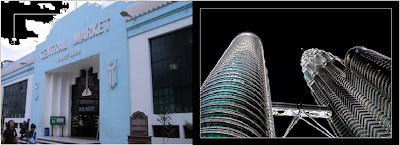The Kellogg Foundation launched KLCC in 2002 in response to the way factors such as diversity, technology and the changing economic landscape were posing new opportunities as well as challenges for local communities.
Crossing Boundaries, Changing Communities is a core philosophy of KLCC, urging the inclusion of non-traditional leaders from diverse backgrounds in the collective decision-making processes of their communities. This philosophy helps community leaders cultivate the relationships and expertise they need to improve neighbourhoods for all of the residents they serve.
2. Freezing of the Past
Central Market is located at Jalan Hang Kasturi, a few minutes away from Petaling Street. It was built in 1888 and originally used as awet market. It has since been classified as a Heritage Site by the Malaysian Heritage Society and it is now a landmark for Malaysian culture and heritage. It is also strategically located within public transport facilities.
Central Market has created a corner to display multi-ethnicity and the stalls are zoned based on the features of each race. The new zone therefore would consist of 3 lanes namely the Lorong Melayu, Straits Chinese and Lorong India.
As Kuala Lumpur experienced its own development at a rapid pace in the 1970s, there were plans to demolish the site. The intervention of the Malaysian Heritage Society proved timely as they successfully petitioned against its deconstruction and the site was declared as a 'Heritage Site'.
3.Transition between the Past and the Present
The transition from software requirements to software architectures has consistently been one of the main challenges during software development. Various methodologies that aim at helping with this transition have been proposed. However, no systematic approach for assessing such methodologies exists. Also, there is little consensus on the technical and non-technical issues that a transition methodology should address. Hence, we present a method for assessing and comparing methodologies for the transition from requirements to architectures. This method also helps validate newly proposed transition methodologies. The objective of such validations is to assess whether or not a methodology has the potential to lead to better architectures. For that reason, this paper discusses a set of commonly known but previously only informally described criteria for transition methodologies and organizes them into a schema.
4.Cultural Crossroads
Malaysia-Truly Asia!" This slogan promotes the idea of Malaysia as Asia's cultural and ethnic melting pot and has captured the imagination of visitors from all over the world.
The Malays, Chinese, and Indians are the three ethnic ingredients that make up the unique nation and culture that is Malaysia After independence from the British Empire in the 1950s, Malaysia's multiethnicity had a tremendous impact on her political, economic and cultural development.
Malaysia Gathering between the beautiful of the past and what it has from magic to reflecting of the Malaysian culture and developing it and the modern which is make it on the top of the countries that trying to be Developed countries with its adherence to the past
5. Collapsing Identity
Malaysia is home to numerous communities and sub-communities each possessing its own defining qualities, qualities that make the communities; the dozens of communities loosely defined for the purpose of convenience or political expediency as Malays, Chinese, Indians or Others. Each of these communities and sub-communities possess their own identifying traits of character, customs, manners as well as cultural heritage, and yet through the intermingling of communities and their cultural expressions and manifestations, this mixture has been a source of pride, even strength, as indicated in the movement towards and the attaining of independence. This amalgam of races was also to become a source of tension in every sense of the word, more or less, subdued or apparent, as the nation's short history of fifty years has demonstrated time and again.



No comments:
Post a Comment